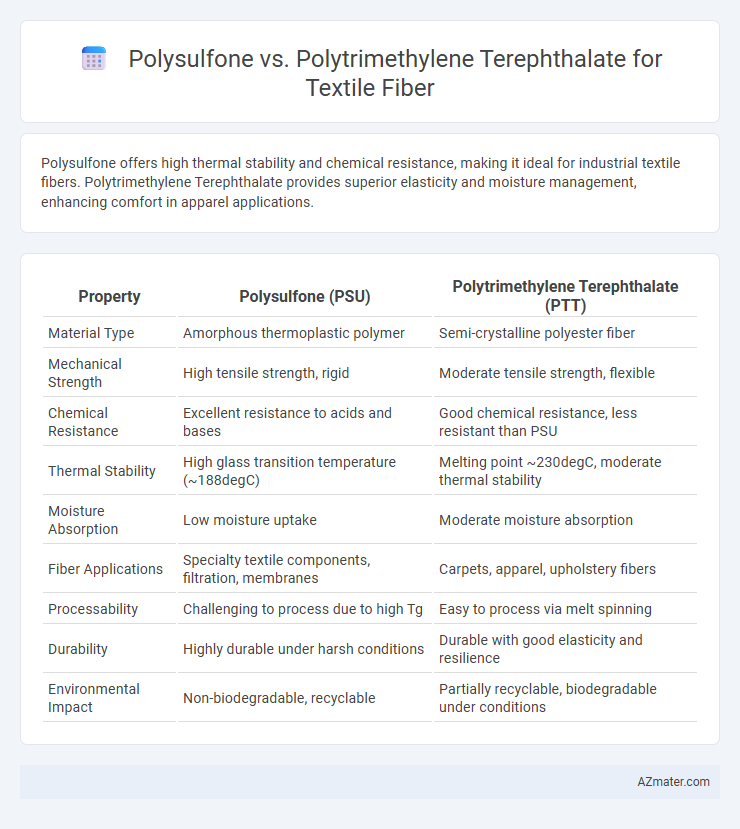Polysulfone offers high thermal stability and chemical resistance, making it ideal for industrial textile fibers. Polytrimethylene Terephthalate provides superior elasticity and moisture management, enhancing comfort in apparel applications.
Table of Comparison
| Property | Polysulfone (PSU) | Polytrimethylene Terephthalate (PTT) |
|---|---|---|
| Material Type | Amorphous thermoplastic polymer | Semi-crystalline polyester fiber |
| Mechanical Strength | High tensile strength, rigid | Moderate tensile strength, flexible |
| Chemical Resistance | Excellent resistance to acids and bases | Good chemical resistance, less resistant than PSU |
| Thermal Stability | High glass transition temperature (~188degC) | Melting point ~230degC, moderate thermal stability |
| Moisture Absorption | Low moisture uptake | Moderate moisture absorption |
| Fiber Applications | Specialty textile components, filtration, membranes | Carpets, apparel, upholstery fibers |
| Processability | Challenging to process due to high Tg | Easy to process via melt spinning |
| Durability | Highly durable under harsh conditions | Durable with good elasticity and resilience |
| Environmental Impact | Non-biodegradable, recyclable | Partially recyclable, biodegradable under conditions |
Introduction to Polysulfone and Polytrimethylene Terephthalate
Polysulfone (PSU) is a high-performance thermoplastic known for its exceptional thermal stability, chemical resistance, and mechanical strength, making it suitable for advanced textile fibers in demanding applications. Polytrimethylene terephthalate (PTT) is a semi-crystalline polyester celebrated for its elasticity, softness, and resilience, offering superior comfort and durability in textile fiber production. Both polymers serve distinct roles in textiles, with PSU excelling in high-temperature and harsh environments, while PTT provides enhanced wearability and aesthetic properties for consumer fabrics.
Chemical Structure and Composition
Polysulfone (PSU) is an amorphous thermoplastic polymer characterized by aromatic rings linked by sulfone (-SO2-) and ether (-O-) groups, providing high thermal stability and chemical resistance. Polytrimethylene Terephthalate (PTT) is a semi-crystalline polyester composed of repeating units of terephthalic acid and 1,3-propanediol, offering elasticity and resilience in textile applications. The presence of sulfone groups in PSU imparts superior oxidative and hydrolytic stability, whereas PTT's ester linkages contribute to biodegradability and enhanced fiber softness.
Mechanical Properties Comparison
Polysulfone fibers exhibit high tensile strength, excellent dimensional stability, and superior resistance to creep under mechanical stress, making them suitable for demanding textile applications requiring durability. Polytrimethylene terephthalate (PTT) fibers demonstrate notable elasticity, good tensile strength, and enhanced resilience to repeated deformation, providing excellent stretch and recovery characteristics for apparel and performance textiles. The mechanical properties of polysulfone prioritize structural integrity under load, whereas PTT emphasizes flexibility and comfort, influencing their respective suitability in technical versus consumer textile markets.
Thermal Stability and Resistance
Polysulfone exhibits superior thermal stability with a high glass transition temperature around 185-190degC, enabling it to maintain structural integrity under prolonged heat exposure, making it ideal for high-performance textile fibers. Polytrimethylene terephthalate (PTT) offers moderate thermal resistance, with melting temperatures near 225degC, but lower glass transition temperature around 60-70degC reduces its performance under continuous thermal stress. For applications demanding exceptional heat resistance and dimensional stability, polysulfone outperforms PTT, while PTT provides more elasticity and comfort for textile use.
Dyeability and Aesthetic Attributes
Polysulfone fibers exhibit limited dyeability due to their inherent hydrophobicity and high crystallinity, resulting in subdued color vibrancy and reduced dye uptake compared to Polytrimethylene Terephthalate (PTT). Polytrimethylene Terephthalate offers superior dye affinity and a broader color gamut, attributed to its semicrystalline structure and chemical composition that facilitate better dye penetration and fixation. Aesthetically, PTT fibers provide enhanced luster, softness, and resilience, making them preferable for high-performance textiles requiring vibrant coloration and appealing hand feel.
Moisture Absorption and Comfort
Polysulfone exhibits low moisture absorption, maintaining dimensional stability and breathability in textile fibers but may feel less comfortable due to limited moisture-wicking properties. Polytrimethylene terephthalate (PTT) offers higher moisture absorption and excellent moisture management, enhancing wearer comfort through improved softness and elasticity. The superior moisture absorption of PTT fibers contributes to better thermal regulation and comfort in activewear compared to the more hydrophobic polysulfone fibers.
Processing Techniques and Fabrication
Polysulfone fibers are commonly processed using melt spinning due to their high thermal stability and resistance to chemical degradation, allowing for precise control over fiber diameter and mechanical properties. Polytrimethylene terephthalate (PTT) fibers are typically fabricated through melt extrusion and subsequent drawing processes, which enhance their elasticity and softness, essential for textile applications demanding comfort and durability. The distinct processing techniques for polysulfone and PTT fibers influence their final textile performance, with polysulfone favored for technical and protective fabrics while PTT excels in apparel and activewear sectors.
Environmental Impact and Sustainability
Polysulfone fibers exhibit high thermal and chemical stability, yet their production involves energy-intensive processes and non-biodegradable polymers contributing to long-term environmental persistence. Polytrimethylene terephthalate (PTT), derived from renewable corn-based sorbitol, offers enhanced biodegradability and lower carbon footprint, making it a more sustainable option in textile manufacturing. The recyclability and biodegradation rates of PTT significantly reduce landfill waste and ecological damage compared to the durability and resistance of polysulfone fibers.
Cost Analysis and Market Availability
Polysulfone fibers typically incur higher production costs due to complex synthesis and limited raw material sources, resulting in premium-priced market positioning. Polytrimethylene terephthalate (PTT) offers more cost-effective manufacturing with abundant feedstock availability, leading to broader market penetration and competitive pricing. Market availability favors PTT fibers because of their established supply chains and growing demand in the textile industry, while polysulfone remains niche due to specialized applications and lower production volumes.
Applications in Textile Fiber Industry
Polysulfone offers exceptional thermal stability, chemical resistance, and mechanical strength, making it ideal for technical textiles and protective clothing applications requiring durability and heat resistance. Polytrimethylene Terephthalate (PTT) excels in softness, elasticity, and wrinkle resistance, widely used in fashion apparel, upholstery, and carpets due to its comfort and aesthetic appeal. In the textile fiber industry, polysulfone is favored for performance textiles, whereas PTT is preferred for consumer-oriented fabrics focusing on comfort and appearance.

Infographic: Polysulfone vs Polytrimethylene Terephthalate for Textile Fiber
 azmater.com
azmater.com